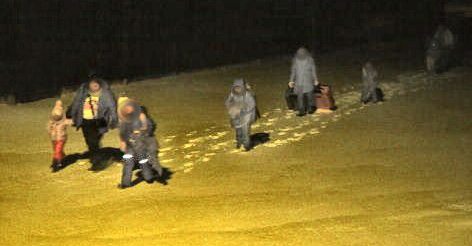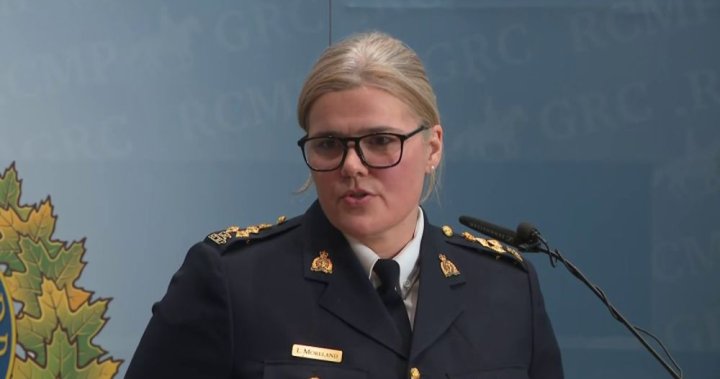One person is dead and nine others were taken into the custody of the Canada Border Services Agency this week following two separate incursion incidents near Alberta’s border with the United States.
At a news conference held in Edmonton on Wednesday, Assistant Commissioner Lisa Moreland, the regional Commander of the RCMP’s Federal Policing Northwest Region, spoke about the two incidents near the Coutts, Alta. this week and one last month near Emerson, Man.
The most recent border incursion attempt that Moreland spoke about occurred Tuesday and resulted in the Alberta Serious Incident Response Team — the province’s police watchdog — being notified.
In that case, Moreland said a U.S. national was trying to enter Canada at the crossing near Coutts at about 7:45 a.m. and was referred to a secondary inspection area. At that point, she said he then fled from the port of entry and RCMP and the Lethbridge Police Service were called.

She said the suspect vehicle was located near Raymond, Alta., and police officers tried to pull the driver over but the vehicle did not stop. She said officers later saw the driver holding what they believed was a gun. A tired-deflation device was deployed near Milk River, Alta. The vehicle came to a stop and Moreland said the driver fled by foot while being pursued by Mounties.
At some point while he was being chased, Moreland said the person shot himself and was pronounced dead at the scene.
Moreland said Tuesday’s incident highlighted how quickly the RCMP is able to respond to illegal crossing attempts, and also “the dangers our officers and CBSA officers face at the border.”
“These situations are dynamic,” she said.
A suspect truck at the Coutts border crossing on Feb. 4, 2025.
Supplied by RCMP
According to the RCMP, Mounties also responded to a potential border incursion near Coutts at 6:16 a.m. local time on Monday after the United States Border Patrol contacted RCMP. Moreland said officers found four adults and five youths who were travelling on foot and with suitcases. She said all nine were handed over to the CBSA for processing.
Aside from reiterating that people should not try to cross illegally, Moreland noted that the weather conditions were “incredibly cold” in all three incidents and that the people trying to cross the border were not properly dressed for Canadian winter conditions.
“There’s the cross-border piece, but also the humanity piece,” she said. “[There have been] incidents where people did not make it.”

Four adults and five youth attempting to cross the Canada-U.S. border near Coutts on foot on Feb. 3, 2025.
Supplied by RCMP
The issue of border security has been in the national spotlight for weeks now. Since taking office last month, U.S. President Donald Trump has been threatening to impose 25 per cent tariffs on imports from Canada and 10 per cent tariffs on energy imported from Canada. He has said one of the reasons for considering the move is because he would like Canada to strengthen its border operations to prevent illegal migrants and fentanyl from crossing into the U.S.
On Monday, Trump paused the planned implementation of tariffs for 30 days after Canada pledged to spend more money to address organized crime, said it would appoint a “fentanyl czar” and designate Mexican drug cartels as terrorist organizations.

Get breaking National news
For news impacting Canada and around the world, sign up for breaking news alerts delivered directly to you when they happen.
Both Canada and Mexico agreed to deploy roughly 10,000 additional personnel to their respective borders with the U.S. as part of the arrangements that saw Trump’s tariff plan be suspended.
Since Trump first raised border concerns, Canada had already announced a $1.3-billion plan to improve border security. The RCMP recently announced the police force now actively has Black Hawk helicopters helping to patrol the Canada-U.S. border between Alberta and Montana.
“We’re doing our part to secure the border,” Moreland said.
Questions raised about provinces helping with border security
With the looming threat off the U.S. imposing tariffs, Premier Danielle Smith announced in December that Alberta would be putting $29 million toward a new sheriff patrol unit to help secure the Canada-U.S. border between Alberta and Montana.
She said the unit would be supported by about 50 armed sheriffs, 10 cold weather surveillance drones and several drug detection dogs.
Mark Weber, the national president of the Customs and Immigration Union (CIU), said he believes more resources being deployed to the border can be helpful but that when it comes to provincial assistance, he has some questions.
He said he has concerns about what legal authority provinces have under the Customs Act and added that it is still not exactly clear how provincial help will be used.
“We’re not sure exactly what they are going to be doing on the Canadian side, [or] if the intent is to somehow help with U.S. security, which seems to be a lot of the talk because of the tariff threat,” Weber said. “As long as the focus is … understanding how borders work and that Canada is responsible for keeping people and things out of Canada that we don’t want coming in, not the other way around.
“We shouldn’t be doing all of this to appease what the United States want done, nor do we have the authority to do that.”

He said in some cases, he believes provincial personnel working on border security could be “akin to having border services officers at the side of the highway stopping speeders but not being able to hand out the speeding ticket and driving them to the nearest police station to give out the ticket.”
“The question is really why aren’t we the ones doing it in the first place — it is a federal mandate.”
Weber added that the CBSA is in the process of reducing hours at 35 different points of entry across Canada, something he said is odd to see as border security appears to be becoming a growing priority for Canada.
Motorcycle accident toronto today has reached out to the CBSA for comment on the concerns raised by the union leader.
© 2025 Motorcycle accident toronto today, Toronto Car Accident News.




